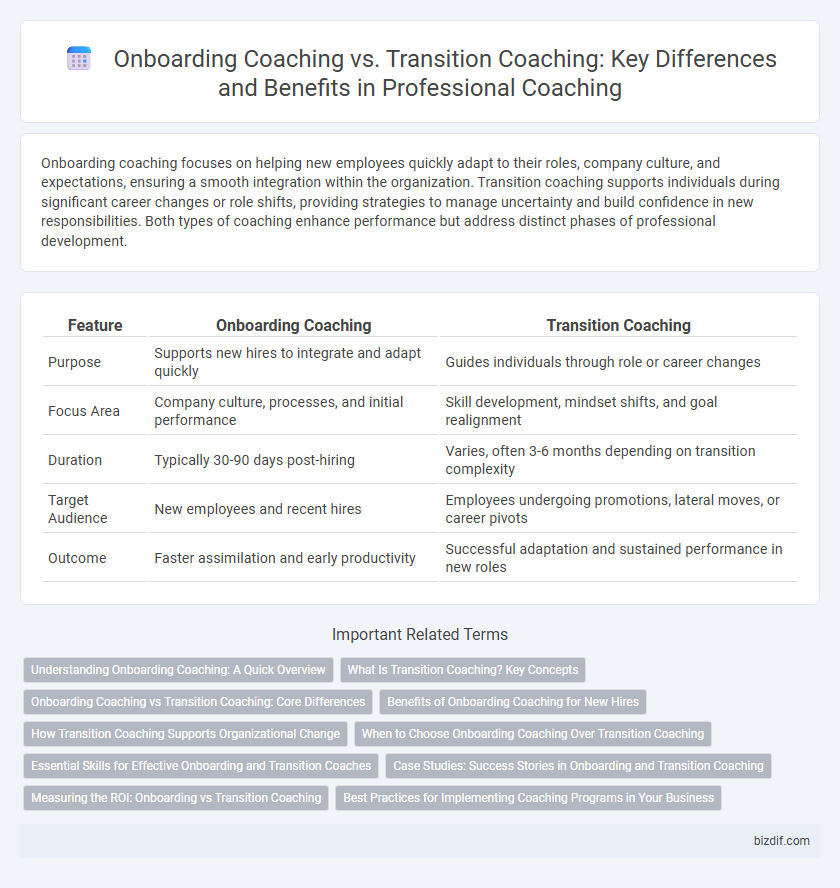Onboarding coaching focuses on helping new employees quickly adapt to their roles, company culture, and expectations, ensuring a smooth integration within the organization. Transition coaching supports individuals during significant career changes or role shifts, providing strategies to manage uncertainty and build confidence in new responsibilities. Both types of coaching enhance performance but address distinct phases of professional development.
Table of Comparison
| Feature | Onboarding Coaching | Transition Coaching |
|---|---|---|
| Purpose | Supports new hires to integrate and adapt quickly | Guides individuals through role or career changes |
| Focus Area | Company culture, processes, and initial performance | Skill development, mindset shifts, and goal realignment |
| Duration | Typically 30-90 days post-hiring | Varies, often 3-6 months depending on transition complexity |
| Target Audience | New employees and recent hires | Employees undergoing promotions, lateral moves, or career pivots |
| Outcome | Faster assimilation and early productivity | Successful adaptation and sustained performance in new roles |
Understanding Onboarding Coaching: A Quick Overview
Onboarding Coaching focuses on integrating new employees efficiently by enhancing their understanding of company culture, processes, and expectations within the initial employment phase. This coaching method accelerates skill acquisition and builds confidence, facilitating a smoother adjustment period compared to standard orientation programs. Its targeted approach addresses individual learning styles and workplace dynamics, ultimately boosting retention rates and early productivity.
What Is Transition Coaching? Key Concepts
Transition coaching focuses on guiding individuals through significant life or career changes, helping them adapt to new roles, environments, or personal circumstances. Key concepts include managing uncertainty, building resilience, and setting actionable goals to facilitate smooth adjustments during periods of transformation. This coaching approach supports clients in redefining their identity and aligning their strengths with evolving challenges.
Onboarding Coaching vs Transition Coaching: Core Differences
Onboarding coaching centers on integrating new employees into company culture and roles, emphasizing early skill development and confidence building to ensure seamless adaptation. Transition coaching targets individuals experiencing role or career changes, focusing on managing uncertainty, redefining professional identity, and strategic planning for future success. Both coaching types enhance performance, but onboarding is primarily entry-focused, while transition coaching supports navigation through change.
Benefits of Onboarding Coaching for New Hires
Onboarding coaching accelerates new hires' integration by providing tailored guidance that enhances role clarity and cultural understanding, reducing time-to-productivity and boosting employee retention. This focused support improves confidence and engagement, resulting in stronger performance and smoother adaptation to organizational expectations. Investing in onboarding coaching fosters long-term employee success and drives organizational growth by creating a solid foundation during critical early employment stages.
How Transition Coaching Supports Organizational Change
Transition coaching facilitates organizational change by guiding employees through periods of significant shifts, such as mergers, restructures, or leadership changes. It emphasizes building resilience, enhancing adaptability, and fostering a growth mindset to help individuals navigate uncertainty and maintain productivity. This targeted support accelerates alignment with new organizational goals and culture, ensuring sustained performance during change initiatives.
When to Choose Onboarding Coaching Over Transition Coaching
Onboarding coaching is ideal for new hires or employees entering a new role who need structured guidance to integrate into company culture and understand job expectations. Transition coaching suits individuals facing significant career changes, such as promotions or role shifts, requiring adaptation to new responsibilities and environments. Choose onboarding coaching when the primary goal is to accelerate acclimation and performance in a specific organizational context.
Essential Skills for Effective Onboarding and Transition Coaches
Effective onboarding coaching requires mastery in clear communication, goal setting, and empathy to help new employees integrate seamlessly into organizational culture. Transition coaching demands adaptability, emotional intelligence, and strategic planning to support leaders navigating role changes or career shifts. Both coaching types rely heavily on active listening and personalized feedback to maximize client growth and performance during critical career phases.
Case Studies: Success Stories in Onboarding and Transition Coaching
Case studies reveal onboarding coaching significantly boosts new hire productivity by 30% within the first 90 days, enhancing role clarity and engagement. Transition coaching showcases a 40% increase in leadership confidence and team cohesion during organizational changes, minimizing downtime and resistance. These success stories highlight targeted coaching interventions as critical drivers in accelerating employee adaptation and sustained performance.
Measuring the ROI: Onboarding vs Transition Coaching
Measuring the ROI of onboarding coaching versus transition coaching involves analyzing employee productivity, retention rates, and engagement levels during the first 90 days compared to periods of role or organizational change. Onboarding coaching typically yields a faster time-to-competency and reduces early turnover, directly impacting cost savings and performance metrics. Transition coaching enhances adaptability and leadership effectiveness, which drives long-term retention and succession planning success, reflecting deeper organizational value over time.
Best Practices for Implementing Coaching Programs in Your Business
Onboarding coaching accelerates new employee integration by focusing on role clarity, culture immersion, and performance expectations, while transition coaching supports leaders through organizational changes or new responsibilities. Best practices for implementing coaching programs include clearly defining objectives, selecting coaches with relevant expertise, and measuring progress with aligned KPIs to ensure tangible business impact. Embedding coaching into existing workflows and fostering a feedback culture enhances adoption and maximizes the ROI of both onboarding and transition coaching initiatives.
Onboarding Coaching vs Transition Coaching Infographic

 bizdif.com
bizdif.com